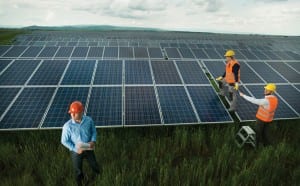An event organised by the Solar Trade Association (STA) in March brought together stakeholders in the sector to appraise the opportunities and threats for the technology in Scotland. Paul Marsh reports.
SOLAR power might be lightening energy bills in Germany, the US and elsewhere but in the UK it has been slow to catch on. It’s a situation not helped by a Government that seems unconvinced of the merits of small-scale renewables, and which in the past year has pared down the support available, most recently with a sharp reduction in the Feed-in-Tariffs (FiTs) and the current consultation on the RHI.
Blitz spirit appeared to be in generous supply amongst the installers, developers and others who gathered at Heriot-Watt’s Riccarton campus in mid-March for this event, which was titled “Solar in Scotland: The future and the opportunity”. There was some licking of wounds but mostly it seemed to be a day to think about how the technology is being deployed, where it is being held back, and where it might be possible to increase the value available to end users.
Scotland to the rescue?
The Scottish Government’s Fergus Ewing – who addressed the meeting – was among those pondering the seemingly irrational logic behind the cessation of Government support – “irrational”, he said, because “instead of the logical approach of reducing the cost of the most expensive methods of generating electricity, the targets have been the least expensive, in onshore [wind] and solar, and at the same time the rationale has been to save money for the consumer – you can’t have it both ways, can you?”
Murmurings discernible ahead of Ewing’s address seemed to express hope that the Scottish Government would extend some support to the industry, maybe in the form of a “Scottish FiT” or something similar. Ewing confirmed that “we won’t be removing existing ROC level of support” – nor, he said, did his government have plans to remove the grandfathering policy with the ROC scheme prior to its closure, as was proposed in England in Wales.
“I don’t like making promises unless I know there is a way I can deliver them,” he told the meeting, “but what we need to do, I think, is find a means of overcoming problems in relation to the FiT tariffs – if one can be found.” He continued: “Whether it’s through power purchase agreements, whether it’s through some innovative forms of funding, capital funding… I’m happy to work with you because very often the best solutions come from industry not from politicians or civil servants.” To that end he was intent on sitting down with groups like the STA and others in the industry, he said, “to find a way to do what we possibly can to advance the cause of solar”.
Ewing’s address came at the end of a day where the challenges to the industry had been considered to the fullest extent, reflecting the STA’s lack of political bias.
Asked about the possible benefits of Brexit, the STA’s Sonia Dunlop suggested it might offer short-term gain for solar installers, in the removal of the EU Minimum Import Price (MIP), which currently adds 7-13% to the price of solar in the UK. But in the long term the political will behind the environmental legislation in this country has clearly been coming from Brussels, so the loss of this controlling influence would be unlikely to benefit the industry.
She outlined some of the areas where the STA is seeking to influence political decision making, and the MIP issue seemed a key one at the moment, coming as it does within the scope of various reviews being conducted by the European Commission, which are likely to be concluded in 2017.
The Paris summit and the EU’s 2030 renewables target have “set the mood music”, she suggested, and provide a global and European framework that points towards ongoing increases in renewables deployment.
Apart from the need to meet environmental goals, other end user priorities were dicussed throughout the day, and benefits that haven’t played too strongly so far but which will likely become more important, such as energy independence and aspirational goals.
Paul Barwell of the STA cited some evidence that adding solar panels to a property increased its value, and Dunlop mentioned a recent survey by Barclay’s, which seemed to show that people were willing to pay an extra £2k for a house with solar PV. However, in a presentation on property valuations and business rates, Thomas McMillan of Savills said his feedback suggested residential solar schemes currently don’t seem to add value to a property, but added this was an area where “we need to continue to get people to recognise the value of it”.
Stuart Elms of Viridian Solar said the industry needed to offer more aesthetic options for property owners, but many of the compelling benefits of the technology have still not made the journey to mass market awareness. “We need to make a home without solar seem like a home with an outside toilet, or without broadband”.
From the solar installers who attended the meeting, there were presentations on a wide spectrum of projects. The FiT situation appears most challenging with the smallest scale, 0-10kW projects, and becomes less so as you ascend the levels of project size. Barwell felt there was a worrying policy vacuum above 1MW at present, with the support available currently insufficient.
The larger 1MW-5MW and standalone projects appear to be a growing focus for “private wire” projects, where localised electricity grids can be set up, operating with a degree of independence from the grid.
Private wire prospects
Private wire will have growing significance as solar developers seek to navigate the “post-subsidy environment” as Lark Energy’s Jonathan Selwyn put it (a term which is maybe now appropriate for the larger, RO-level projects, at least). Grid constraints are obviously putting a brake on solar energy deployment in the UK, and DNOs face huge difficulties with managing an outdated grid. However he felt it was important to be clear about the support the solar industry is extending to the grid, and was disdainful of whispering and misinformation in government circles that implied renewables were presenting a cost burden for the grid. The solar industry has spent around £0.25 billion in recent years on upgrading the grid, he said, adding that his own firm has contributed £15 million to this figure.
•









